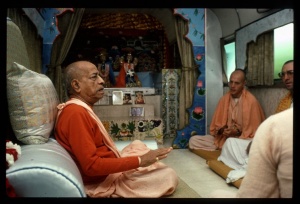SB 3.31.47

A.C. Bhaktivedanta Swami Prabhupada
TEXT 47
- tasmān na kāryaḥ santrāso
- na kārpaṇyaṁ na sambhramaḥ
- buddhvā jīva-gatiṁ dhīro
- mukta-saṅgaś cared iha
SYNONYMS
tasmāt — on account of death; na — not; kāryaḥ — should be done; santrāsaḥ — horror; na — not; kārpaṇyam — miserliness; na — not; sambhramaḥ — eagerness for material gain; buddhvā — realizing; jīva-gatim — the true nature of the living entity; dhīraḥ — steadfast; mukta-saṅgaḥ — free from attachment; caret — one should move about; iha — in this world.
TRANSLATION
Therefore, one should not view death with horror, nor have recourse to defining the body as soul, nor give way to exaggeration in enjoying the bodily necessities of life. Realizing the true nature of the living entity, one should move about in the world free from attachment and steadfast in purpose.
PURPORT
A sane person who has understood the philosophy of life and death is very upset upon hearing of the horrible, hellish condition of life in the womb of the mother or outside of the mother. But one has to make a solution to the problems of life. A sane man should understand the miserable condition of this material body. Without being unnecessarily upset, he should try to find out if there is a remedy. The remedial measures can be understood when one associates with persons who are liberated. It must be understood who is actually liberated. The liberated person is described in Bhagavad-gītā: one who engages in uninterrupted devotional service to the Lord, having surpassed the stringent laws of material nature, is understood to be situated in Brahman.
The Supreme Personality of Godhead is beyond the material creation. It is admitted even by impersonalists like Śaṅkarācārya that Nārāyaṇa is transcendental to this material creation. As such, when one actually engages in the service of the Lord in various forms, either Nārāyaṇa or Rādhā-Kṛṣṇa or Sītā-Rāma, he is understood to be on the platform of liberation. The Bhāgavatam also confirms that liberation means to be situated in one's constitutional position. Since a living entity is eternally the servitor of the Supreme Lord, when one seriously and sincerely engages in the transcendental loving service of the Lord, he is situated in the position of liberation. One should try to associate with a liberated person, and then the problems of life, namely birth and death, can be solved.
While discharging devotional service in full Kṛṣṇa consciousness, one should not be miserly. He should not unnecessarily show that he has renounced this world. Actually, renunciation is not possible. If one renounces his palatial building and goes to a forest, there is actually no renunciation, for the palatial building is the property of the Supreme Personality of Godhead and the forest is also the property of the Supreme Personality of Godhead. If he changes from one property to another, that does not mean that he renounces; he was never the proprietor of either the palace or the forest. Renunciation necessitates renouncing the false understanding that one can lord it over material nature. When one renounces this false attitude and renounces the puffed-up position that he is also God, that is real renunciation. Otherwise, there is no meaning of renunciation. Rūpa Gosvāmī advises that if one renounces anything which could be applied in the service of the Lord and does not use it for that purpose, that is called phalgu-vairāgya, insufficient or false renunciation. Everything belongs to the Supreme Personality of Godhead; therefore everything can be engaged in the service of the Lord; nothing should be used for one's sense gratification. That is real renunciation. Nor should one unnecessarily increase the necessities of the body. We should be satisfied with whatever is offered and supplied by Kṛṣṇa without much personal endeavor. We should spend our time executing devotional service in Kṛṣṇa consciousness. That is the solution to the problem of life and death.